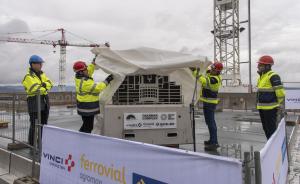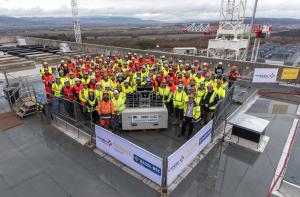A "formidable adventure" comes to an end
On Wednesday 13 December, Fusion for Energy Deputy Program Manager Romaric Darbour accepted a rather cumbersome gift: a steel cutaway of the Tokamak Complex mounted on a 1.650-tonne reinforced concrete base. Presented by the representatives of the VFR consortium, the gift symbolically marked the completion of the main construction works on the Tritium Building—a "formidable adventure" under Europe's responsibility that spanned 14 years and involved close to 2,000 workers from dozens of subcontracting companies.
An integral part of the Tokamak Complex, the Tritium Building will host the systems and equipment that store, handle and recycle deuterium and tritium, the two hydrogen isotopes that will fuel the fusion reaction in ITER. However, as the building also accommodates non-tritium-related components, such as the gas injection system and HVAC, cooling, and vacuum pumping equipment, the building will be needed as soon as ITER operation starts.
The five-storey structure is a nuclear building, with some areas where steel reinforcement is exceptionally dense. It is also home to many rooms, with no less than 300 cubicles distributed throughout the different levels.
"Like everything in ITER, things weren't simple," quipped Romaric, "and the path to success was not easy. But over the past 14 years we have developed competences that will prove precious for the construction of future fusion plants." For Jérôme Laclau, the director of Vinci Construction Large Projects in France, the first of these competences was being able to "build a project team" capable of meeting the challenges of a unique construction project and deliver it "on time, and even a bit ahead of schedule."
The companies that form the VFR consortium (Vinci, Ferrovial and Razel-Bec), he said, "have delivered the best of their expertise." At the core of this effort, stressed VFR Project Director Aurélien Gayrard-Bouzereau, "are the workers who did their job, rain or shine, by 5 degrees below zero as well as under the scorching sun, when temperatures can reach 40 degrees in Provence."
Too heavy to be used as a bookend on Romaric's shelf, the steel-and-concrete gift will probably join a previous symbol of construction achievement, the olive tree that stood for a few days at the top of the Tokamak Building in 2019 and was later replanted at the entrance of ITER Headquarters.



